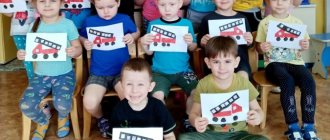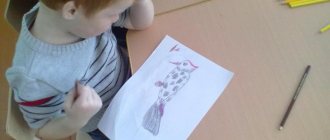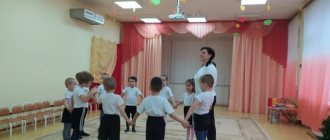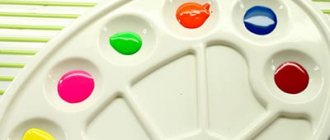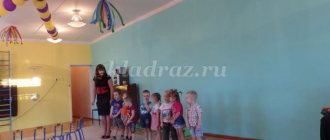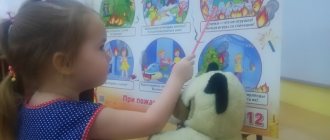lesson notes for the math club in the middle group
Dispensing: circles 5 pcs., squares 5 pcs., “ice tracks” made of cardboard of different lengths and widths (2 pcs.), “snowballs” of different sizes (2 pcs.)
Progress of the lesson.
1.Game meeting between smart guys and smart girls. 2 teams - boys and girls. Teams take turns counting out 5 cars and 4 dolls and placing them on the table. Specify the quantity. Discuss familiar methods of comparison (overlay and application)." 5 cars and 4 dolls - compare which is more. 4 dolls and 5 cars - compare. which is less."
2. Similar work is carried out with handouts (circles and squares). They equalize using one of the following methods.
Physical education minute.
Game "Nose, ear".
3. Game exercise “Arrange the figures.” Each team places in one basket -
balls, in the other - cubes. Specify the names of the figures.
4. Comparison of “ice tracks” in length and width, conclusion: one track is large, the other is small. The smart guys roll a big “snowball” along the big path, and the smart ones roll a small “snowball” along the small path.
Award for both teams.
Lesson 17
Goal: Practice counting sounds within 5. Practice counting objects by touch within 5. Strengthen ideas about the meaning of words yesterday, today, tomorrow. Learn to compare 3 objects by width, arrange them in descending and ascending order, denote the results of comparison with the words: wide, narrower, narrowest, narrow, wider. The widest.
Materials: flannelgraph, 3 scarves of the same color, the same length and different widths, 3 rectangles of the same color, the same length and different widths.
Handout: cards with buttons in bags (1-5 buttons on cards), sets of cards with circles (1-5 circles on cards), plot pictures depicting children playing winter games (4-5 pieces each), glockenspiel.
Progress of the lesson.
1. Make a riddle about winter. Remember the items of winter clothing. On the flannelgraph there are scarves of the same color of the same length and different widths. Determine how they are similar and how they differ (by the method of overlay and application). The concepts wide, narrow, and narrowest are fixed.
2.Game situation “Going down (ascending) the steps.” Rectangles are shown. Determine how they are similar and how they differ. Arrange them in a ladder (starting from the narrowest to the widest). The concepts narrow, wider, and widest are fixed.
Physical education 1, 2, 3, 4, 5
The little bunny began to jump.
It's a lot of fun for the little bunny to jump.
He jumped 10 times.
3. Game exercise “Show the same amount.” The bag contains a card with a certain number of buttons. The child counts the buttons by touch and shows a card with the same number of circles. He explains why he showed this particular card. Children take out a card with buttons from the bag and check the correctness of the answer. The exercise is repeated 2-3 times.
MAGAZINE Preschooler.RF
Project for the development of mathematical concepts in the middle group. “One, two, three, four, five, mom and I will count.”Completed:
- Garayeva A.V.
- Indenok E.N.
Municipal budgetary preschool educational institution kindergarten "Rosinka" 2021, Chernogorsk.
Project type: research-creative, short-term.
Project participants: middle school children, teachers, parents.
Relevance
Parents and teachers are always concerned with the question of how to ensure the full development of a child in preschool age, how to properly prepare him for school. One of the indicators of a child’s intellectual readiness for school is the level of development of mathematical and communication abilities. For a more effective introduction of mathematics into the child’s mind, its study should, of course, begin in kindergarten. At this age, the child’s brain catches everything down to the smallest detail, and if sometimes the baby does not understand everything, it’s not scary, anyway, some part of the learning process is embedded in his memory, the brain begins to get used to new data. Gradually, after repetitions, the child will easily distinguish between geometric shapes and numbers, and learn to add and subtract.
It is very important in this regard to have the right approach, namely to interest the child using the method of games and hints, otherwise strict classes will quickly become a boring time for the child, and he will not want to return to it anymore.
The relevance of this issue prompted the idea to create, together with parents, a project to teach children of middle preschool age the ability to think logically, analyze, develop memory, attention, and most importantly, correctly express their thoughts out loud.
With the help of didactic games and tasks for ingenuity, ingenuity, and joke tasks, we clarify and consolidate children’s ideas about numbers, the relationships between them, geometric figures, time and space relationships. Game situations with elements of competition, reading passages of fiction motivate children and direct their mental activity to find ways to solve problems.
Using entertaining mathematics, we put preschoolers in search conditions, awaken an interest in winning, therefore, children strive to be fast and resourceful.
I believe that teaching children mathematics in preschool age contributes to the formation and improvement of intellectual abilities: logic of thought, reasoning and action, flexibility of the thought process, ingenuity and ingenuity, and the development of creative thinking.
Formulation of the problem.
During classes on the formation of elementary mathematical concepts, many children quickly lost interest in mathematics, and had difficulties with thinking and attention.
To increase the level of mathematical development, the activity of children, and develop their interest in mathematics, we decided to use entertaining material: puzzles, mazes, educational games, sheets with tasks for independent completion, and various multimedia presentations.
For this purpose, parents were involved in the production of teaching aids for classes.
Objective of the project
To contribute to the creation of pedagogical conditions for the development of mathematical concepts, curiosity in middle-aged children, and cognitive activity through entertaining developmental material prepared together with the students’ parents.
Tasks
- To create conditions for preschoolers to master mathematical concepts, to ensure the successful development of children’s abilities and thinking.
- To promote the development of the ability to count within 10, to correctly use ordinal and cardinal numbers.
- To help consolidate the ability to recognize and name geometric shapes.
- Promote the development of mental operations: logical thinking, ingenuity, visual memory, imagination, ability to compare and analyze.
- To promote the development of interest in games that require mental stress and intellectual effort.
- To promote independence, the ability to understand a learning task and carry it out independently.
- Encourage parents to participate in the implementation of the project and engage in activities to develop mathematical concepts with their children at home.
Expected Results
- Increasing the level of mathematical concepts in children of middle preschool age.
- Children show interest in fun math games.
- Children independently find ways to solve cognitive problems, strive to achieve their goals, overcome difficulties,
are able to transfer learned experience to new situations.
4. Parents actively participate in the selection of entertaining material for classes and in the production of teaching aids.
5. Parents' awareness of the importance of developing elementary mathematical concepts in children, expanding parents' knowledge about game forms and methods in teaching.
Preparatory stage
Determining the theme of the project.
Setting the goals and objectives of the project.
Drawing up a plan for the main stage of the project.
Selection of methodological and fiction literature on the topic of the project.
Selection of didactic, outdoor games, physical education lessons on the topic of the project.
Making educational games in mathematics.
Involving parents in working together on the project:
creative task: choose mathematical riddles, problems, puzzles and colorfully arrange this material; parents' help in making
didactic games on FEMP.
Design of the folder - movement "Mathematics for preschoolers" .
Consultation for parents “How to organize children’s games at home using entertaining materials”
Main stage
Reading fairy tales and poems with elements of counting: “The Three Little Pigs” , “Seven Little Goats” , “Snow White and the Seven Dwarfs” , “Flower - Seven Flowers” , “Three Bears” .
Viewing the computer presentation “Tank Engine Chukh - Chukh learns numbers” , “Tank Engine Chukh - Chukh learns figures” .
Coloring math coloring books (by numbers, drawing numbers, coloring numbers.
Construction: “Rocket” made from cubes.
Working with counting sticks.
Didactic games with mathematical content: “Train made of cubes” , “What has changed?” , “Show as much” , “Beetles” , “Vases with flowers” , “Pine cones and acorns” , “Build a path” , “Circle Lotto ” , “Put it together” , “Geometric lotto” , “The fourth wheel” , “Get in order” , “Count the cubs” , “Count with your fingers” , “What does a number look like” , “Steps” , “Compare the values” , “Colorful squares” , “Young geometrician” , “Funny fish” , “Apple orchard” , "Flower Glade" .
Guessing riddles, entertaining questions, comic puzzles, puzzles.
Outdoor games: “Find yourself a partner” , “Math track” , “Math hedgehog” , “Math blanket” .
Finger gymnastics.
Physical education minutes: “One - two” , “Guess how many” , “Name three objects” ,
“Big and small” , “Charging” .
Conclusion
The project has been completed.
During the work on the project, the parents of the students became active and direct participants in the creative process, which grew into a close community. The project allowed them to realize their abilities and talents, enrich their knowledge and skills in raising children with new experiences in family education. Children have a need for systematic mental activity and the ability to create independently, experiencing joy. Each child reached his own higher level of development.
Project for the development of mathematical concepts in the middle group.
For the development and improvement of children’s cognitive, mental and creative abilities, didactic play is a very effective method. The children completed tasks in various educational games with great interest.
Didactic game “Show the same amount”
Didactic game “Build a path”
Didactic game “Find the figure”
To reinforce the numbers and figures, we invited the children to color a train consisting of figures, where each color was designated by its own number; the children enthusiastically did this work.
After working with the handouts, we looked at the presentations “The Little Engine Chukh - Chukh teaches numbers” , “The Little Engine Chukh - Chukh learns figures” using multimedia resources.
We tried to involve parents in our project. All parents responded with pleasure and completed various tasks at home with their children.
Our Ulyana Salmonovich is very interested in tigers, and she once asked her mother how many stripes a tiger has? And so my mother came up with an idea on how to interest Ulya in learning numbers. She came up with various tasks and they gradually completed them with her.
We learned to count using a collection of tigers.
Each strip was counted.
In conclusion, they painted the tiger with paints and Ulya independently counted the stripes she had drawn.
Ulyana decided to tell and show all the children in the group how she and her mother counted the stripes of a tiger, for this she brought coloring books with images of tigers to the kindergarten, all the children colored with great pleasure and listened to Ulyana’s story.
Misha Kozin and his mother studied geometric shapes at home using wooden inserts. I learned to lay out the number of colored stripes on the board that were depicted on the cubes.
Nastya Konovalchuk’s mother gave her the opportunity to construct various figures from sticks that they studied, and Nastya coped with the task perfectly.
We concluded our project by producing various didactic materials together with parents for further games in the group.
| Next > |
